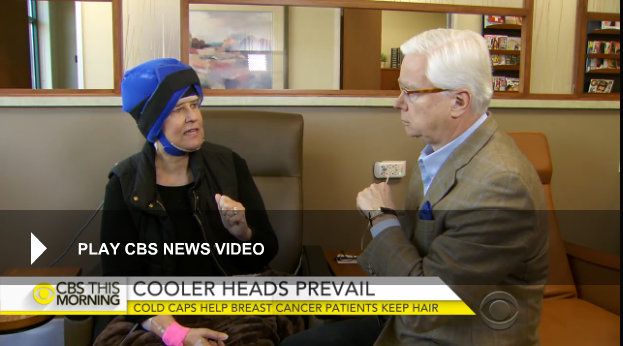Cold caps help breast cancer patients save their hair
October is National Breast Cancer Awareness Month. One in eight women in the U.S. will be diagnosed with breast cancer in her lifetime.
Women who’ve been treated for the disease say one of the most difficult things about chemotherapy is losing their hair. When the treatment kills cancer cells, it kills healthy hair cells right along with it, reports CBS News correspondent Barry Petersen.
But for many women that doesn’t have to happen. There is a technique called cold caps, used for decades in Europe, but almost unknown in the U.S.
Mary Nell Wolff is using one at a Denver clinic while undergoing chemo.
In the most recent study, roughly 66 percent of women kept more than half of their hair. The cold cap is chilled with dry ice to 30 below. As it warms, a new one is strapped on tightly every 20 to 30 minutes. This goes on for eight hours.
“It’s not really pain. It is an overall feeling of I just want this off my head,” Wolff said.
Doctors have different ideas about why it works.
One theory is that it constricts blood flow, keeping the chemo from reaching the scalp. Another is that it freezes many of the hair follicles and the chemo is simply shut out.
“Is it working?” Petersen asked.
“It is working. I have the majority of my hair. The oncologist told me this morning that I would have been completely bald had I had not used the cold cap,” Wolff said.
She gets moral support from her husband – CBS News’ Barry Petersen. Yes, they are together on this journey.
“Why is maintaining your hair important to a woman?” Petersen asked.
“I think it gives you a sense of control. It gives you a piece of dignity,” Wolff said.
It doesn’t work for all chemo drugs, or for cancers carried through the blood like leukemia. There are concerns that blocking the chemotherapy could let cancer spread to the scalp, but doctors don’t believe it’s likely.
“Our opinion is that the risks are very, very small, if any,” said Dr. Tessa Cigler, an oncologist at New York’s Weill Cornell Breast Cancer Center.
Cigler sees a positive impact from the caps.
“I think some of it is a look-good-feel-good” effect for patients, she said.
The other effect she’s noticed is on doctors and how they respond to women who still have their hair.
“We’ve been surprised at how our interactions are a little bit different,” Cigler said, adding that it’s in a “more positive” sense.
Using these caps can cost a patient several thousand dollars out-of-pocket; they are rented by the month.
Another version called DigniCap circulates coolant through one cap. It received FDA approval last December, but it’s far less available since it must be leased by hospitals. Users then pay by the treatment.
Neither of the options is reimbursed by insurance.
That’s why Bethany Hornthal in San Francisco helped found the non-profit “Hair to Stay,” to help women who can’t afford the cold caps. The organization has offset the costs for more than 170 women.
“I think that insurance needs to step in here and to level the playing field,” Hornthal said.
In New Jersey, Susan Melchione demonstrated the DigniCap for us. She decided it was worth the cost.
“I can go out and just be who I am and not have the breast cancer define me,” Melchione said.
“What does that mean, not have the breast cancer define me?” Petersen asked.
“Not live the cancer, but live going through the struggle or the treatment of it, and coming out the other end and being fine,” Melchione said.
All the women we spoke to for this story, doctors and patients, stressed the importance of awareness. While there can be hefty out-of-pocket costs, women can’t make the choice to save their hair without knowing about the treatment option – and most doctors are not talking about it.
Petersen said he is happy to report that his wife had her last chemo four months ago, and she was able to keep her hair.
This story appeared on CBS News. Read the original and watch the video here.




